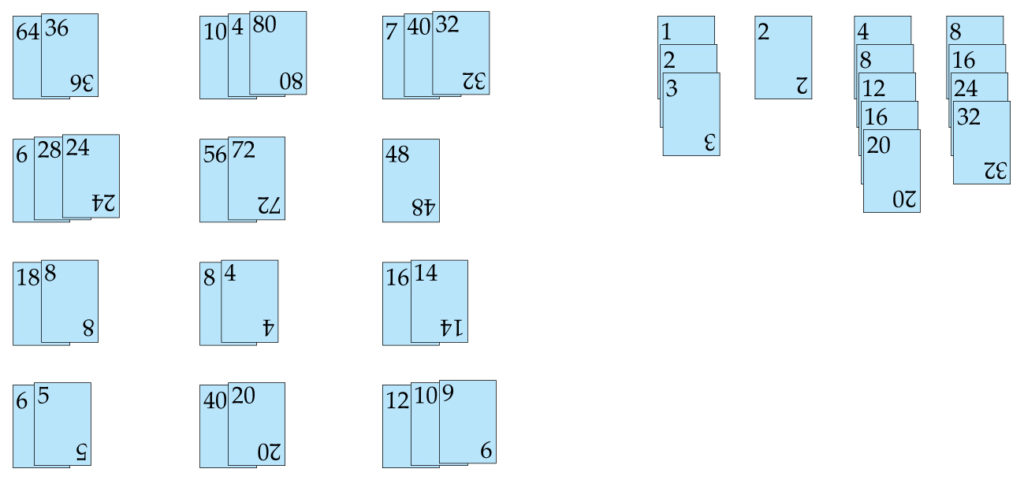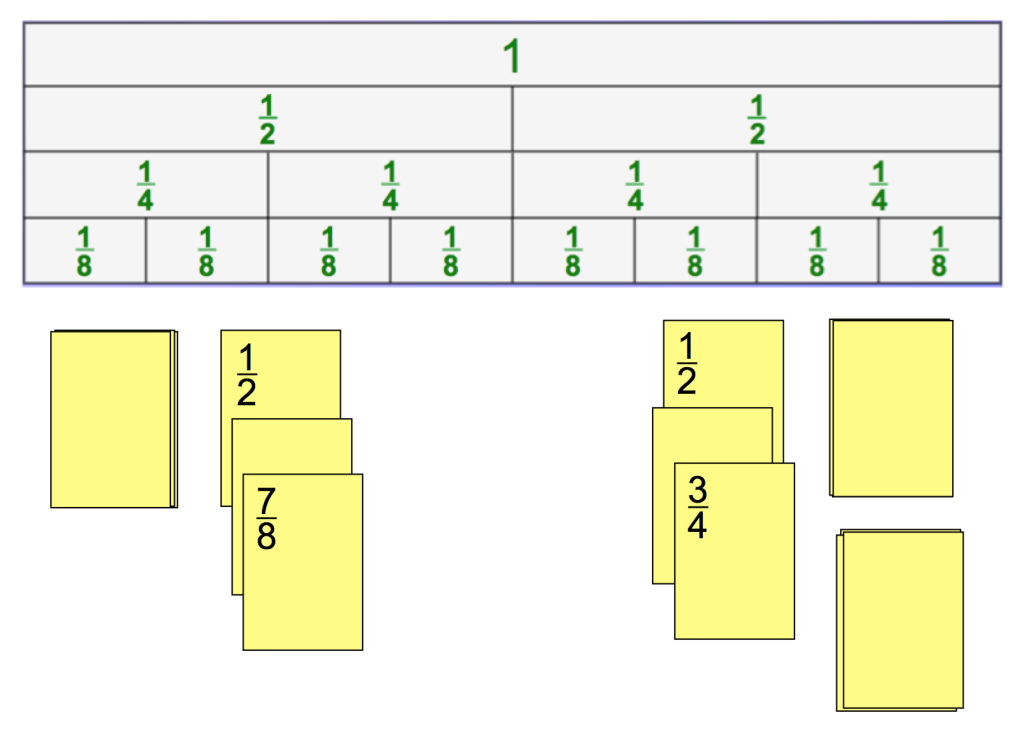Ahhhh. The holidays are here! This means you get to see your family, you can enjoy making good meals and treats with your children, and you get time off from teaching. And then you get to worry that they are not going to remember the math facts that you just taught them….
There is a wonderful solution right at your fingertips. Play math card games! These are games that the cousins or grandparents can play with your children. They take little prep time and can be taken wherever your family celebrates time together. I can pretty much guarantee that they will have loads of fun (and never mind that they are keeping their facts fresh).
So what kind of games am I talking about? Let me share three games with you; an easy one for the littles, a medium-hard one for those working on multiplication, and a fun game with fractions that everyone will enjoy.
The first game is called Go to the Dump. It’s a Go Fish sort of game. Remember that game? It uses a deck of cards with numbers 1 to 9. We have a deck of cards for you here, but you certainly could just a deck of regular playing cards without the 10s and face cards (reminding little ones that the aces are 1). Deal five cards to everyone and put the rest of the cards in the middle of the playing area face down. Then, rather than looking for two matching numbers to make a pair, like the regular Go Fish game, look for two numbers that add up to 10 and are a “match.” So, 1 and 9 are a pair, 2 and 8, 3 and 7, 4 and 6, and 5 and 5.
Have the players check their hands for pairs. If matches are found, lay them down on the table side by side. This makes it easy to check players’ work and makes shuffling super easy after the game. Then, one player will ask the person on their left for a card to match one in their hand. If the card is available, they give it to the first player and they get to ask for another card. If (or when) the asked card is not available, the second player says “Go to the dump” and the first player takes a card from the stock. Their turn is now over, even if they received a match.
The second player now asks the person on their left for a card. Play continues all around the circle. If someone matches all their cards and has no more in hand, they take five more cards from the stock. Play continues until all the cards have been matched.
This is a game that younger children like. A lot. It’s a game that we parents can play with just a few brain cells involved. And the kids are working on the important facts of 10, while having fun!
This next game is for those working on their multiplication facts: Multiples Solitaire. A certain amount of strategy is needed to win this solitaire game. It will provide practice for four sets, say 1s, 2s, 4s, and 8s. Use the first ten multiples of each set; so that’d be 1, 2, 3, 4, 5, 6, 7, 8, 9, 10, and 2, 4, 6, 8, 10, 12, 14, 16, 18, 20, and 4, 8, 12, 16…. You get what I’m talking about. We have a deck of multiplication cards here. Or you could grab a stack of index cards and make your own sets.
By the way, if you use sets that are multiples of each other, like 2, 4, & 8, or 3, 6, & 9, there will be more “duplicate” cards and more opportunities for winning.
Start by shuffling the cards together and lay them face up in fans of three. The last fan will have only one card. The point of the game is to collect the four sets in order, taking the cards from the fans. But only the top card of a fan may be collected.

Columns are started with the lowest number of a set (1, 2, 4, and 8 in my example) as they become available. The top card of a fan, the 32-card, for example, may be moved to another fan if it immediately precedes (in a multiples set) the card it is being moved to, the 36-card. Because 32 and 36 are consecutive multiples of 4, the 32-card can be moved to free up the card underneath. A group of cards may be moved, provided they are all consecutive multiples of a set used. In the game shown above, the 28 and 24 may be moved to the 32, freeing up the 6.
Also, the last card of a multiple’s column may also be moved to another column. This gives flexibility to help win the game. If no cards can be played, pick up the fanned cards, shuffle, and lay the cards again in fans of three.
This is a great game to help your child work on their multiples. Because this is a solitaire game, you don’t have to be involved. Or, if you want to play the game together, become a team and work to beat the cards with as few reshuffles as possible. Or maybe work to be the fastest team in the family!
Finally, let’s take a peek at a fraction game: Fraction War. Did you play the game of war for as a child? It feels like I played this game for days on end!
This is a two-player game. For beginners, I recommend the following cards in a deck of 34 cards: three each of 3⁄4, 3⁄8, 5⁄8, 7⁄8; four of 1⁄8; five each of 1 and 1⁄4; and eight of 1⁄2. Again, we have a fraction deck of cards for you, or you can pull out the index cards again and make your own.
Keep the cards face down and divide them evenly between the two players. The goal is to capture all the cards from your friend. Each player takes the top card from their stack and lays it face up in the middle of the table. The player whose card is greater takes both cards. Use the fraction chart to help the players determine the larger fraction. Draw this chart if you don’t have one on hand.

If the players turn over the same cards, it’s a war! When this happens, which will be relatively frequently, both players place a card from their stack face down on top of their first card, then another card face up. The player who has the highest card now takes all six cards. Again, the goal is to get all the cards from your friend. Now, go!
We also have the Fraction War game as an app, if you might be experiencing some travel time. We also have the Go to the Dump game as an app, which we renamed as Go to Ten.
We have so many more games for you and yours. We hope you have a wonderful holiday season filled with happiness, joy, and math games!
This blog is also published with SPED Homeschool, where RightStart Math proudly partners.
